All other things being equal, that is correct.Just out of curiosity - the difference between smaller and larger driver pair in the same baffles is only in SPL capability? I feel like trying this out with some woofers I already have at hand.
SPL capability would vary directly based on the Sd * Xmax difference between two drivers.
Dave.
I'll add that its because edge diffraction / dipole null stuff is associated to baffle size. One can have small or big driver on the baffle and the upper usable frequency pretty much stays put. For this reason minimal baffle is best, or conversely as big driver is best as possible, or multiple drivers. Max SPL capability for the usable bandwidth, which is from baffle sized wavelengths and longer.
Some discussion here:
https://www.diyaudio.com/community/...m-open-baffleless-full-range-speakers.374043/
And the Celestion SL6000 system:
https://www.stereophile.com/floorloudspeakers/892/index.html
https://www.diyaudio.com/community/...m-open-baffleless-full-range-speakers.374043/
And the Celestion SL6000 system:
https://www.stereophile.com/floorloudspeakers/892/index.html
Ok, making double dipole like so increases SPL without affecting bandwidth of the driver. In other words the usable bandwidth upper limit stays the same while sensitivity increases. If drivers were on same baffle the baffle size would increase which brings down the dipole null/diffraction, the usable bandwidth. Trick here is to keep distance of the two as small as possible in order not to drop the usable bandwidth again.
Perhaps there is not much difference if two drivers were like so one behind another or right next to each other in a minimal baffle, perhaps its more marketing or looks than anything else. Certainly I would keep baffle minimal what ever the driver arrangement, and to have low frequency extension and SPL capability just have as many and big drivers as needed to meet the goal. On the other hand, if these were bottom drivers of a 4way system, then it would be possible to enlarge the structure, baffle or h-frame or something, as much as possible before introducing the diffraction /interference into pass band.
This is ideal 15" driver on minimal baffle
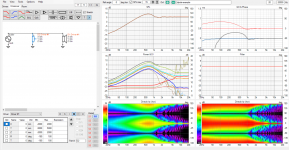
And here is two coincident (physically impossible) to demonstrate the sensitivity boost of 6db
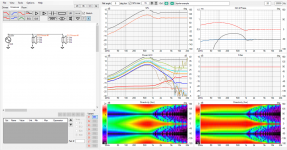
When distance of the two is increased, one behind the other, the usable bandwidth top starts to drop
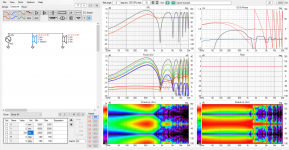
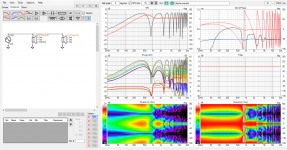
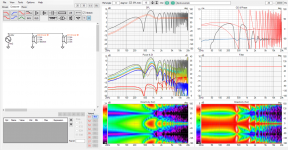
Here is situation where both drivers are on minimal baffle, one top of another not back to back like in above sims. Back to back configuration with 10cm spacing seems to be ~3db louder on the bottom than if the drivers were next to each other but I think this is how VCAD makes the ideal responses I think, just a moment I'll try it out. Also difference in DI, mainly in vertical directivity, unfortunately no Vertical polar map shown on the attachments but this is quick and easy VCAD exersize for everyone to try out 😉
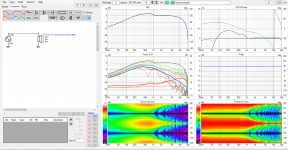
Edit. yes, diffraction tool has total sensitivity referenced to 0 no matter how many ideal drivers, hence the experiment should simulate each driver separately on both cases to be comparable. Here is comparison that ought to match reality, also vertical polars directivity shown (normalized).
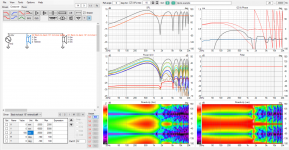
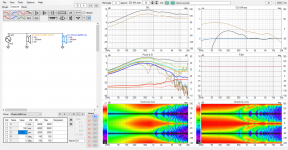
Perhaps there is not much difference if two drivers were like so one behind another or right next to each other in a minimal baffle, perhaps its more marketing or looks than anything else. Certainly I would keep baffle minimal what ever the driver arrangement, and to have low frequency extension and SPL capability just have as many and big drivers as needed to meet the goal. On the other hand, if these were bottom drivers of a 4way system, then it would be possible to enlarge the structure, baffle or h-frame or something, as much as possible before introducing the diffraction /interference into pass band.
This is ideal 15" driver on minimal baffle

And here is two coincident (physically impossible) to demonstrate the sensitivity boost of 6db

When distance of the two is increased, one behind the other, the usable bandwidth top starts to drop




Edit. yes, diffraction tool has total sensitivity referenced to 0 no matter how many ideal drivers, hence the experiment should simulate each driver separately on both cases to be comparable. Here is comparison that ought to match reality, also vertical polars directivity shown (normalized).


Last edited:
Perhaps there is not much difference if two drivers were like so one behind another or right next to each other in a minimal baffle, perhaps its more marketing or looks than anything else.
Two drivers side by side on the same baffle will displace twice the air enabling it to play significantly louder cleanly. One behind the other will displace the same amount of air but with effectively twice the motor and voice coil. It will be more efficient as shown above. In the range where SPL is limited by displacement it will be no louder than a single speaker but will where the SPL is limited by power. Given clean SPL at low frequencies is a significant "con" for OB speakers (to set against "pro"s not discussed) the difference is likely to be significant.
There are some directivity effects higher in frequency depending on the baffle size vs. driver size (tends to get more pronounced when driver is significantly smaller than baffle).Just out of curiosity - the difference between smaller and larger driver pair in the same baffles is only in SPL capability?
If you're just testing a single vs. compound configuration on the same size baffles, you'll probably still get good difference trend data though.
Two 15" drivers side by side on ob look ugly. Those same drivers one after another look cool 🙂Two drivers side by side on the same baffle will displace twice the air enabling it to play significantly louder cleanly. One behind the other will displace the same amount of air but with effectively twice the motor and voice coil. It will be more efficient as shown above. In the range where SPL is limited by displacement it will be no louder than a single speaker but will where the SPL is limited by power. Given clean SPL at low frequencies is a significant "con" for OB speakers (to set against "pro"s not discussed) the difference is likely to be significant.
Soo what you're saying is there's no replacement for displacement? Uh... just can't get away from it!Two drivers side by side on the same baffle will displace twice the air enabling it to play significantly louder cleanly. One behind the other will displace the same amount of air but with effectively twice the motor and voice coil. It will be more efficient as shown above. In the range where SPL is limited by displacement it will be no louder than a single speaker but will where the SPL is limited by power. Given clean SPL at low frequencies is a significant "con" for OB speakers (to set against "pro"s not discussed) the difference is likely to be significant.
- Home
- Loudspeakers
- Multi-Way
- Why 'double' di-pole?